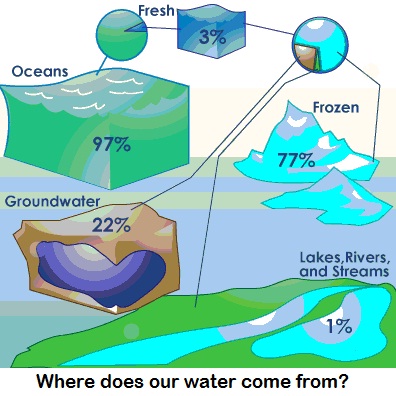|
|
|
|
 There's
often discussion in the news of the world's dwindling water supply, but
this isn't entirely accurate. The amount of water isn't diminishing, but
the demand for it is steadily increasing. Some scientists believe that
the world's population, currently at 6 billion, will double by 2050. In
addition, the amount of water that is clean and drinkable is steadily
decreasing because of pollution. There's
often discussion in the news of the world's dwindling water supply, but
this isn't entirely accurate. The amount of water isn't diminishing, but
the demand for it is steadily increasing. Some scientists believe that
the world's population, currently at 6 billion, will double by 2050. In
addition, the amount of water that is clean and drinkable is steadily
decreasing because of pollution.
For many people in industrialized countries, getting water is as easy as
turning on a faucet, and it's rather inexpensive. But freshwater isn't
evenly distributed throughout the world. More than half of the world's
water supply is contained in just nine countries: the United States,
Canada, Colombia, Brazil, the Democratic Republic of Congo, Russia,
India, China and Indonesia. Urban areas, obviously, have a greater need
for water beyond the basics for drinking and sanitation. But
overpopulation in undeveloped countries means that many people don't
even get the basics.
Most of the world's freshwater -- about 2.4 million cubic miles (10
million cubic kilometers) of it is contained in underground aquifers.
The rest comes from:
Rainfall (after accounting for evaporation): 28,500 cubic miles (119,000
cubic kilometers)
Man-made reservoirs: 1,200 cubic miles (5,000 cubic km)
Lakes: 21,830 cubic miles (91,000 cubic km)
Rivers: 509 cubic miles (2,120 cubic km)
Water distribution has everything to do with political boundaries,
economic development and wealth. In Mexico City, for example, 9 percent
of the population uses 75 percent of the available water, and a
crumbling infrastructure means that up to half of the water supply is
lost through pipe leaks and evaporation.
Some countries don't have enough clean water for their rapidly growing
populations, and they can't afford the infrastructure necessary to clean
and transport it. For example, most people in China's cities suffer from
water shortages, and most of China's groundwater, lakes and rivers are
polluted. About 700 million Chinese people have access only to drinking
water that does not meet standards set by the World Health Organization.
Countries in the Middle East use the least amount of water per person
because there are so few natural sources of freshwater. In contrast, the
usage of water is higher in the United States than in any other country,
with around 60,000 cubic feet (1,700 cubic meters) of water used per
person in 2002. But even within the United States, there are some states
and regions that don't contain enough water to supply their populations.
Coastal regions of Florida have so much saltwater that they must have
freshwater piped in from inland areas, which has led to political
disputes over control of the water supply.

Source: http://science.howstuffworks.com |
|


 There's
often discussion in the news of the world's dwindling water supply, but
this isn't entirely accurate. The amount of water isn't diminishing, but
the demand for it is steadily increasing. Some scientists believe that
the world's population, currently at 6 billion, will double by 2050. In
addition, the amount of water that is clean and drinkable is steadily
decreasing because of pollution.
There's
often discussion in the news of the world's dwindling water supply, but
this isn't entirely accurate. The amount of water isn't diminishing, but
the demand for it is steadily increasing. Some scientists believe that
the world's population, currently at 6 billion, will double by 2050. In
addition, the amount of water that is clean and drinkable is steadily
decreasing because of pollution.